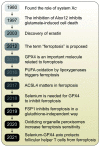Ferroptosis in acute leukemia
- PMID: 37010259
- PMCID: PMC10278762
- DOI: 10.1097/CM9.0000000000002642
Ferroptosis in acute leukemia
Abstract
Ferroptosis is an iron-dependent cell death pathway that is different from apoptosis, pyroptosis, and necrosis. The main characteristics of ferroptosis are the Fenton reaction mediated by intracellular free divalent iron ions, lipid peroxidation of cell membrane lipids, and inhibition of the anti-lipid peroxidation activity of intracellular glutathione peroxidase 4 (GPX4). Recent studies have shown that ferroptosis can be involved in the pathological processes of many disorders, such as ischemia-reperfusion injury, nervous system diseases, and blood diseases. However, the specific mechanisms by which ferroptosis participates in the occurrence and development of acute leukemia still need to be more fully and deeply studied. This article reviews the characteristics of ferroptosis and the regulatory mechanisms promoting or inhibiting ferroptosis. More importantly, it further discusses the role of ferroptosis in acute leukemia and predicts a change in treatment strategy brought about by increased knowledge of the role of ferroptosis in acute leukemia.
Copyright © 2023 The Chinese Medical Association, produced by Wolters Kluwer, Inc. under the CC-BY-NC-ND license.
Conflict of interest statement
None.
Figures



References
-
- Chen X, Kang R, Kroemer G, Tang D. Broadening horizons: The role of ferroptosis in cancer. Nat Rev Clin Oncol 2021;18: 280–296. doi: 10.1038/s41571-020-00462-0. - PubMed
Publication types
MeSH terms
Substances
LinkOut - more resources
Full Text Sources
Medical

